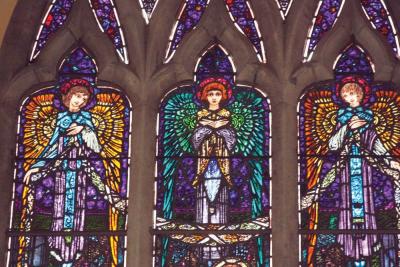December 1, 2015
By Judy Enright
Special to the BIR
Christmas seems like a perfect time to remind future visitors to Ireland about the wondrous works of the stained glass artist Harry Clarke. His magnificent windows can be found in numerous places around the country, and you won’t be sorry if you spend time looking for them.
Born on March 17, 1889, he left school at 14 to join his father’s stained glass and ecclesiastical decorating business. He won several scholarships and studied stained glass in London and France.
During his life, Clarke was commissioned to create more than 160 windows. There are 17 churches in Co. Mayo with Harry Clarke windows, so the Mayo County Council published a guide (available in the Castlebar office) as part of the Heritage Plan 2006-2011. St. Mary’s Church in Ballinrobe also published a book about its collection, which is reputed to be one of the largest in the country.
WINDOWS SOLD
We were reminded about Harry Clarke’s enduring stained glass skills after reading that an unnamed Jesuit priest was the top bidder in a fiercely contested auction last summer of church windows made by the Harry Clarke Studios. The Dublin-based priest paid 31,000 euros – 10 times the estimate – for a single panel depicting “Saint Francis Xavier preaching in the Orient.” He also paid 21,000 euros for a large, three-panel window of St. Francis Xavier. Both windows were made by commission in the 1930s for a church in Co. Kilkenny, but were never collected from the studios. Although the pieces were made after Clarke died, some of the artists worked directly under him.
 Stained glass window by the Harry Clarke Studios in St. Patrick’s Church, Lahardaun, Co. Mayo.The stained glass auction lots sold for a total of 88,500 euros, well ahead of the pre-auction estimate of 25,000.
Stained glass window by the Harry Clarke Studios in St. Patrick’s Church, Lahardaun, Co. Mayo.The stained glass auction lots sold for a total of 88,500 euros, well ahead of the pre-auction estimate of 25,000.
The windows, owned by Harry’s late son David, were made for churches in Ireland, Wales, and New Zealand in the mid-20th century but, for various reasons, were never collected or installed and have been in storage for years. Auctioneers said the trustees of David’s estate approached the National Museum of Ireland to buy them, but terms could not be reached.
Although Harry died in 1931, The Harry Clarke Studios in Dublin continued to make stained glass windows until the business closed in 1973.
Among other lots in the auction was a window depicting Adam and Eve designed for a New Zealand church but never sent. It sold for 9,500 euros. A single panel for a window, titled “St. Bernadette and Our Lady of Lourdes, which originally had two panels sold for 6,500 euros. The pre-auction estimate was 500 euros. The window had been commissioned for a church in Wales but the priest there declined to pay packaging and shipping costs of 33 pounds sterling.
NEWPORT WINDOWS
The first Harry Clarke windows I ever saw sit over the high altar in St. Patrick’s in Newport, Co. Mayo. “The Last Judgment” there took four years to complete and has been described as Clarke’s most magnificent work. The window includes his self-portrait, said to portray his prolonged suffering from poor health – he was 41 when he died en route home to Ireland and a month before his studio installed the final window at St. Patrick’s in Newport.
I went to see the work in the hilltop Newport church after being told that former pastor – Canon Michael MacDonald – sold his life insurance policy to pay for the windows he commissioned in 1926. What a treasure he left for Newport and the many visitors to St. Patrick’s.
If you can’t make it to Ireland, you can see Clarke windows in the Basilica of St. Vincent de Paul in Bayonne, N.J., and more in the Wolfsonian–Florida International University design museum in Miami, FL. You can also find his windows in Australia, England, Northern Ireland, Scotland, and Wales.
PUB MEALS
It’s always interesting to read reviews of various sorts in various publications. Probably the most important thing to remember when you read a review is that the reviewer may have picked a bad or good day at a particular establishment and his or her analysis may not necessarily be a true picture.
I recently read a story by Sorcha Pollak in the Oct. 30 edition of The Irish Times detailing recommendations in the 2016 Michelin Eating Out in Pubs Guide. Michelin recommends the food at 32 pubs in 15 Irish counties as well as in a total of 590 pubs in the Republic, Northern Ireland, England, Scotland, and Wales.
It’s interesting to read the reviews when you’ve visited an establishment yourself. I agree with some of the recommendations – some of the pubs were chosen, in my opinion, because they have name recognition rather than quality.
My favorite pub – the Grainne Uaile in Newport, Co. Mayo – escaped notice. I have eaten there many times and have found the food consistently excellent. I’m not talking about soup and sandwich meals, but full meals – an entree with potato and vegetable. Two other Mayo pubs are listed and I totally agree with one, The Tavern in Murrisk, and have enjoyed meals there a number of times. However, I was not impressed by the food at the other, Cronin’s Sheebeen in Westport. Maybe I need to give the latter another try.
Co. Down led the Michelin listings with six recommended pubs, followed by Co. Cork with five, Co. Clare with four, and Co. Kildare with three. Counties Dublin, Galway and Mayo each had two, while Antrim, Kerry, Leitrim, Louth, Sligo, Tipperary, Wexford and Wicklow had one each.
 Detail from “Adoration of the Magi,” a Harry Clarke stained glass window in Kilmaine, Co. Mayo.
Detail from “Adoration of the Magi,” a Harry Clarke stained glass window in Kilmaine, Co. Mayo.
Wild Honey Inn in Lisdoonvarna, Co. Clare, and Toddies at The Bulman in Kinsale, Co. Cork, both received an “Inspectors’ Favourites” commendation and were described in the guide, according to Pollak’s story, as “establishments found to be particularly charming and which offer something extra special.”
The Irish listings included: Co. Antrim, Billy Andy’s at Mounthill, near Larne; Co. Clare, Morrissey’s in Doonbeg, Vaughan’s Anchor Inn in Liscannor, Wild Honey Inn in Lisdoonvarna and Linnane’s Lobster Bar in New Quay; Co. Cork, Mary Ann’s in Castletownshend, Poacher’s Inn in Bandon, Deasy’s in Clonakilty, Cronin’s in Crosshaven and Toddies in Kinsale; Co. Down, Pheasant in Annahilt, Poacher’s Pocket in Comber, Parson’s Nose and Plough Inn, both in Hillsborough, Pier 36 in Donaghadee, and Balloo House in Killinchy.
Also, Co. Dublin, Old Spot and Chop House, both in Ballsbridge;
Co. Galway, Moran’s Oyster Cottage in Kilcolgan and O’Dowd’s in Roundstone (we heartily agree with this recommendation!);
Co. Kerry. O’Neill’s Seafood Bar in Caherciveen; Co. Kildare, Harte’s in Kildare, Ballymore Inn in Ballymore Eustace and Fallon’s in Kilcullen; Co. Leitrim, Oarsman in Carrick-on-Shannon; Co. Louth,
Fitzpatricks in Jenkinstown; Co. Mayo, The Tavern in Murrisk and Sheebeen in Westport; Co. Sligo, Hargadons in Sligo Town; Co. Tipperary, Larkins in Garrykennedy; Co. Wexford, Lobster Pot in Carne and Co. Wicklow, Byrne & Woods in Roundwood.
It’s great to see Ireland’s many pubs recognized for their food, which is often of good quality and of very good value.
Pollak quoted Rebecca Burr, editor of the guide, as saying the demand for good quality food in the relaxed setting of a local pub is still increasing. “More and more pubs are serving flexible all-day menus – incorporating breakfast, brunch and afternoon tea. The pub industry should be congratulated for moving with the times.”
TIDY TOWNS
Hooray for Letterkenny, Co. Donegal, winner of the 2015 Tidy Town title. Letterkenny topped 860 villages and towns to become the eighth Donegal town to win the designation since the competition began in 1958. Letterkenny was also named Ireland’s tidiest large urban center.
Other winners in this year’s Tidy Town competition include: Clonegal in Co. Carlow, tidiest village; Listowel in Co. Kerry, tidiest small town and Westport, Co. Mayo, tidiest large town.
The competition was originally designed to encourage residents to pick up litter but now awards marks in a range of categories including use/development of natural amenities and landscaping. Every year, towns across Ireland vie for the title.
TRAVEL
There are lots of deals available online and from your favorite travel agent at this time of year and it’s a great time of year to make plans.
Enjoy Ireland whenever and wherever you go and happy holidays to all.

